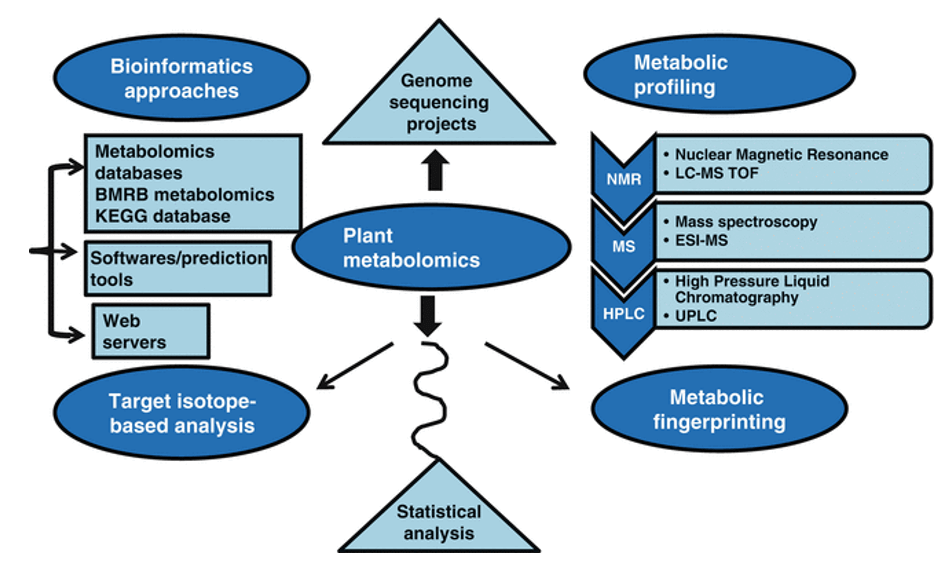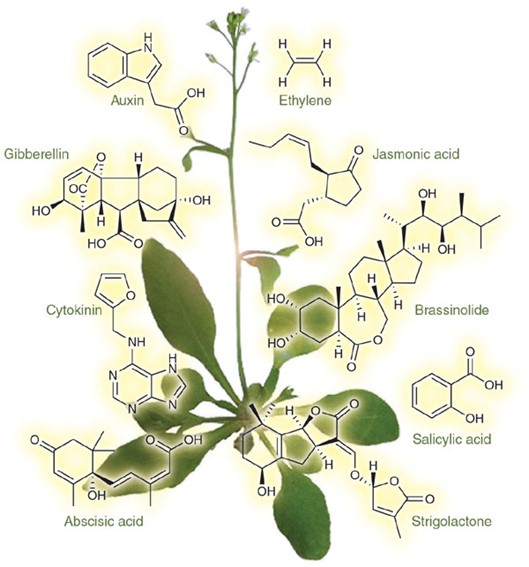What is Plant Metabolomics?
Within the intricate tapestry of plant biology, plant metabolites stand as the small but mighty actors, orchestrating a multitude of chemical reactions that underpin the life of plants. These metabolites encompass a broad spectrum of molecules, each with its unique role and significance. Among them, primary metabolites such as sugars, amino acids, organic acids, and nucleotides serve as the foundational building blocks for essential cellular processes. They are the currencies of energy production, structural formation, and growth regulation within plant cells.
Complementing the primary metabolites are the enigmatic secondary metabolites. These compounds, including alkaloids, flavonoids, terpenoids, and phenolic compounds, often take center stage as plant defenses and communication agents. They are the compounds responsible for the tangy aroma of herbs, the vibrant colors of flowers, and the bitter taste of certain leaves. Secondary metabolites serve as a plant's chemical arsenal, defending against herbivores, pathogens, and environmental stressors, while also playing a pivotal role in interactions with other organisms.
Intriguingly, the study of plant metabolites extends beyond their mere identification and classification. It delves into the dynamic interplay of these molecules within the plant's biological landscape. This holistic approach to understanding plant metabolism is encapsulated in the field of plant metabolomics. Plant metabolomics equips scientists with the tools and methodologies to navigate the intricate pathways of plant metabolism comprehensively.
Through the lens of metabolomics, researchers aim to capture a snapshot of the entire metabolite complement within a plant, revealing not only the identities and quantities of metabolites but also the fluctuations and adaptations that occur in response to changing environmental conditions, genetic modifications, and developmental stages. This discipline utilizes advanced analytical techniques, including mass spectrometry and nuclear magnetic resonance spectroscopy, to decipher the language of metabolites written in mass, structure, and concentration.
Specific Projects and Services for Plant Metabolomics at Creative Proteomics
Metabolite Profiling: Comprehensive analysis of a plant's metabolite profile, including primary and secondary metabolites, using advanced analytical techniques such as LC-MS.
Metabolite Identification: Identification of individual metabolites present in plant samples through spectral matching and database searches, providing information about compound structures and chemical properties.
Quantitative Analysis: Accurate quantification of metabolites to determine their relative abundance in different plant tissues or under varying conditions, enabling the tracking of metabolic changes.
Metabolic Pathway Analysis: Investigation of metabolic pathways within plants to understand how metabolites are interconnected and the key enzymes and regulatory points involved.
Stress Response Studies: Assessment of how plants respond to various environmental stressors (e.g., drought, salinity, temperature) by monitoring changes in metabolite levels and identifying stress-related biomarkers.
Comparative Metabolomics: Comparative analysis of metabolite profiles between different plant species, varieties, or genotypes to identify unique metabolite signatures and genetic variations.
Metabolomics in Agriculture: Application of metabolomics to enhance crop yield, quality, and disease resistance by identifying metabolites associated with desirable traits and developing targeted breeding strategies.
Bioactive Compound Discovery: Identification of bioactive compounds within plants for potential pharmaceutical, nutraceutical, or cosmetic applications.
Metabolomics in Biotechnology: Utilization of metabolomics to optimize the production of valuable compounds in plants, such as biofuels or specialty chemicals.
Metabolomics in Ecological Studies: Investigation of the role of plant metabolites in ecological interactions, such as plant-herbivore interactions, and their impact on ecosystem dynamics.
Data Integration: Integration of metabolomics data with genomics, transcriptomics, and proteomics data to provide a holistic understanding of plant biology and function.
Customized Metabolomics Projects: Tailored metabolomics projects designed to address specific research questions or meet the unique needs of clients in academia, industry, or government organizations.
Plant Metabolomics Analysis Strategies
Plant Targeted Metabolomics
Plant Targeted Metabolomics focuses on quantifying specific plant metabolites of interest. This approach involves selecting a predefined set of metabolites and accurately measuring their concentrations.
- Metabolite Selection: Specific metabolites are chosen based on research objectives, allowing for the focused analysis of particular compounds or pathways.
- Analytical Techniques: High-sensitivity and selective methods such as Liquid Chromatography-Mass Spectrometry (LC-MS) or Gas Chromatography-Mass Spectrometry (GC-MS) are employed to measure the selected metabolites.
- Quantitative Accuracy: Targeted metabolomics emphasizes precise quantification, using calibration curves and reference standards to determine absolute metabolite concentrations.
- Data Analysis: Data analysis is typically straightforward, often involving statistical methods to compare metabolite concentrations across different samples or conditions.
Applications:
Biomarker Discovery: Targeted metabolomics is frequently used to identify biomarkers associated with specific plant traits, diseases, or responses to environmental factors.
Pathway Analysis: Researchers can delve into specific metabolic pathways by quantifying key intermediates and end products.
Plant Untargeted Metabolomics
Plant Untargeted Metabolomics provides a comprehensive overview of all detectable metabolites within plant samples, without prior knowledge of their identities. This approach offers a holistic view of plant metabolite composition.
- Comprehensive Profiling: Untargeted analysis detects and identifies a wide range of metabolites, including known and unknown compounds.
- High-Resolution Techniques: High-resolution Mass Spectrometry (HR-MS) and LC-MS are commonly used for untargeted metabolomics, enabling detailed structural information about metabolites.
- Metabolite Identification: Untargeted analysis involves metabolite identification by comparing experimental data (e.g., mass spectra, NMR spectra) to spectral libraries or databases.
- Data Processing: Data preprocessing and statistical analysis are applied to detect significant differences in metabolite profiles across samples.
Applications:
Discovery: Untargeted metabolomics is employed to discover new metabolites and gain insights into unexpected biochemical pathways within plants.
Comparative Analysis: Researchers can compare metabolite profiles across different plant varieties, species, or under varying environmental conditions to understand metabolic responses.
Hypothesis Generation: Untargeted metabolomics generates hypotheses about the roles of specific metabolites in plant biology, which can then be further investigated.
Plant Lipidomics Services:
Plant Lipidomics Services focus on studying lipid metabolism within plants, including the analysis of lipids such as fatty acids, triglycerides, and phospholipids.
- Lipid Analysis: Specialized lipidomics techniques, such as lipid mass spectrometry, are employed to analyze and identify lipid metabolites within plant samples.
- Structural Identification: Determining the structures of lipid molecules, including details about fatty acid chain lengths, saturation levels, and other structural characteristics.
- Functional Studies: Investigating the functional roles and regulation of plant lipids in processes such as growth, development, and stress responses.
Plant Metabolomics Analytical Techniques
Liquid Chromatography-Mass Spectrometry (LC-MS):
LC-MS combines liquid chromatography with mass spectrometry to separate and analyze complex mixtures of metabolites in plant samples. It is particularly effective for polar and semi-polar compounds.
- Agilent 1290 Infinity II LC
- Thermo Scientific Q Exactive Plus Mass Spectrometer
- Waters ACQUITY UPLC coupled with a mass spectrometer
Gas Chromatography-Mass Spectrometry (GC-MS):
GC-MS is well-suited for analyzing volatile and thermally stable metabolites. It involves the separation of compounds through a gas chromatograph followed by mass spectrometric detection.
- Agilent 7890B Gas Chromatograph
- Agilent 5977A Mass Spectrometer
- Thermo Scientific TSQ 8000 Evo GC-MS
High-Resolution Mass Spectrometry (HR-MS):
HR-MS instruments offer exceptional mass accuracy and resolution, making them ideal for the accurate identification and quantification of metabolites, including isotopologues and adducts.
- Thermo Scientific Orbitrap series (e.g., Q Exactive, Orbitrap Fusion)
- Bruker maXis Impact
- Waters Synapt G2-Si High Definition Mass Spectrometer
Tandem Mass Spectrometry (MS/MS):
MS/MS, or tandem mass spectrometry, is used to fragment and analyze specific ions, providing structural information about metabolites. It is valuable for metabolite confirmation and characterization.
- Thermo Scientific TSQ Triple Quadrupole Mass Spectrometers
- AB Sciex QTRAP 6500 LC-MS/MS System
Direct Infusion Mass Spectrometry (DIMS):
DIMS allows for the rapid analysis of crude extracts without the need for chromatographic separation, making it suitable for high-throughput metabolomics studies.
- Waters Xevo G2-XS QTof
- Bruker Impact II ESI-Q-TOF Mass Spectrometer

Sample Requirements for Plant Metabolomics
| Sample Type | Recommended Quantity (Fresh) | Recommended Quantity (Dried) |
|---|
| Leaf Tissues | 50-100 mg | 20-50 mg |
| Roots and Tubers | 100-200 mg | 50-100 mg |
| Seeds and Grains | - Small Seeds (e.g., Arabidopsis) | 5-10 mg | - |
| - Larger Seeds and Grains | 20-50 mg | - |
| Fruits and Vegetables | 50-100 mg | 20-50 mg |
| Stems and Stalks | 100-200 mg | 50-100 mg |
| Whole Plants | - Small Plants (e.g., Arabidopsis) | 100-200 mg | - |
| - Larger Plants | 500 mg - 1 g | - |
| Extracts and Isolates | Variable | Variable |
Plant Metabolomics Data Analysis
| Projects Analyzed | Description |
|---|
| Data Preprocessing | - Data Cleaning | Remove noise, artifacts, and outliers to enhance data quality. |
| - Data Alignment | Align data from different samples or time points for meaningful comparisons. |
| - Normalization | Normalize data to correct for variations in sample quantity or instrument response. |
| Feature Extraction | - Peak Detection | Identify peaks corresponding to metabolites in the data. |
| - Retention Time | Assign retention times for identified peaks. |
| Metabolite ID | - Database Matching | Match detected peaks to metabolite databases for identification. |
| - MS/MS Spectra | Use MS/MS spectra to confirm metabolite identities. |
| Statistical Analysis | - Multivariate Analysis | Employ PCA, PLS-DA, or OPLS-DA to identify sample groupings or discriminate variables. |
| - Univariate Analysis | Perform t-tests, ANOVA, or similar tests to identify significant metabolite changes. |
| - Pathway Analysis | Analyze metabolite sets to discover affected metabolic pathways. |
| Visualization | - Heatmaps | Create heatmaps to visualize metabolite patterns across samples or conditions. |
| - Volcano Plots | Generate volcano plots to visualize significantly changed metabolites. |
| - Pathway Maps | Visualize metabolic pathways affected by changes in metabolite levels. |
| Annotation | - Biological Context | Interpret metabolite data in the context of biological processes and pathways. |
| - Biomarker Discovery | Identify potential biomarkers associated with specific conditions or traits. |
| Reporting | - Data Summary | Summarize key findings and significant metabolites. |
| - Publication | Prepare data for publication in research papers or reports. |
For Research Use Only. Not for use in diagnostic procedures.











